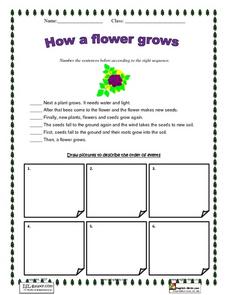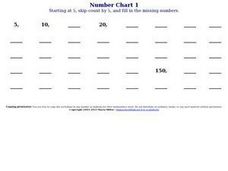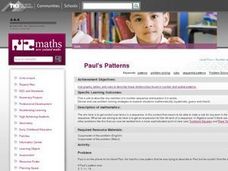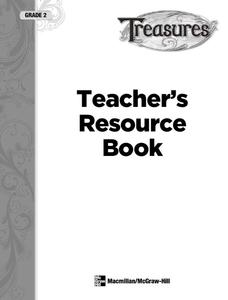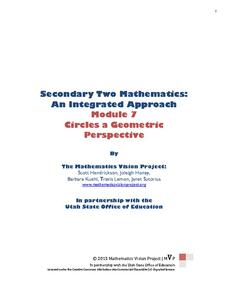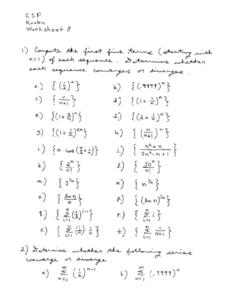Curated OER
Ordinals
Use beaded necklaces to practice with ordinal numbers and sequencing. For the first, scholars color the beads blue, red, or yellow based on their given positions (1st, 3rd, etc.). The next set of beads has learners do the opposite,...
Curated OER
How a Flower Grows
English Language Learners demonstrate their ability to sequence the steps in a process. After reading six sentences that describe how a flower grows, learners identify the right sequence and illustrate the steps. An answer key is provided.
Curated OER
A Fibonacci Primer
Upper graders explore the Fibonacci sequence. They examine the characteristics of the Fibonacci sequence, list the properties of the sequence and determine how it connects to Pythagorean Triples. Related thinking questions are included.
Curated OER
Worksheet 6 - Improper Integrals
In this improper integral worksheet, students determine the convergence or divergence of functions. They explore the sequence in the series. This one-page worksheet contains six multi-step problems.
Weston Wood
Joseph Had a Little Overcoat
Create a cross-curricular learning experience based on the children's book Joseph Had a Little Overcoat with this collection of learning activities. Starting with a class reading of the story, children go on to learn about the...
Curated OER
Annotating Poetry
Use text marking and highlighting to explore the structure of a poem. After listening to Allan Ahlberg read "Please Mrs. Butler," learners locate stanzas and patterns on their copy of the poem using the text marking technique. Class...
Curated OER
Story Structure Slide Show
Analyzing the sequence of actions in dramatic stories leads to deeper comprehension of story structure. The class identifies the main actions in each section of a story and develops frozen tableau's for the identified actions of the...
Curated OER
Skip Counting By Hundreds
There are 6 different number sequences for learners to complete. Each contains missing number. They skip count by hundreds to determine which number will best fill in the blank.
Curated OER
Starfish Surprises
In this missing numbers worksheet, young scholars write the missing numbers covered by the starfish in the patterns. Students complete 6 problems total.
Curated OER
A Creative Presentation
Bring writing to life with this lesson in which elementary and middle schoolers create a display of the imagery they identify in a series of Gary Paulsen books. They read the suggested materials, identify imagery and descriptive...
Curated OER
Number Chart 12: Skip Counting by 5
In this skip counting worksheet, students fill in the numbers to complete a pattern of skip counting by 5. Students begin with the number 5 and write the numbers as they skip count to 200.
Curated OER
Oral Presentation
Practice public speaking in this oral presentation lesson plan. Middle schoolers list the characteristics of a powerful speaker. They watch a video of two speakers, compare them and discuss the qualities of a good speech. Afterwards,...
Curated OER
Paul's Patterns
Fourth graders listen to the problem. As the students work ask them questions that require them to describe the patterns in their own words.
If the students are having problems with finding the patterns encourage them to explore the...
McGraw Hill
Phonics Teachers Resource Book
Looking to improve your classes literacy program? Then look no further. This comprehensive collection of resources includes worksheets and activities covering everything from r-controlled vowels and consonant digraphs, to the...
THUP Games
Monkey Math School Sunshine
Hang out at the beach and listen to some relaxing tunes, all while developing basic math skills. An endless source of fun and learning for young children!
Virginia Department of Education
Weather Patterns and Seasonal Changes
Get your class outside to observe their surroundings with a lesson highlighting weather patterns and seasonal changes. First, learners take a weather walk to survey how the weather affects animals, people, plants, and trees during...
Bowland
Patchwork Cushions
Find out if there are enough squares. Given diagrams for the first four figures in a sequence, pupils try to determine the next figure. Individuals find the number of square and triangle pieces of fabric that are required to make...
Mathematics Vision Project
Quadratic Functions
Inquiry-based learning and investigations form the basis of a deep understanding of quadratic functions in a very thorough unit plan. Learners develop recursive and closed methods for representing real-life situations,...
Oregon Department of Education
Building Number Sense
It's never too early to begin a child's math education. This collection of fun hands-on activities engage youngsters in building their number sense as they learn how to count objects, identify numerals, compare amounts, and much more.
Core Knowledge Foundation
A Time for All Seasons - Summer
The sun is shining and the birds are singing, what better time to teach young learners about the fun season of summer. In this week-long science series, children learn how the rotation and orbit of the earth influence...
Radford University
Fibonacci is All Around
One ratio to rule them all. Young mathematicians investigate the Fibonacci sequence and the Golden Ratio. To begin the first lesson, they use a spreadsheet to see how the Fibonacci sequence gives the Golden Ratio. The second lesson...
Mathematics Vision Project
Circles: A Geometric Perspective
Circles are the foundation of many geometric concepts and extensions - a point that is thoroughly driven home in this extensive unit. Fundamental properties of circles are investigated (including sector area, angle measure, and...
Curated OER
Sequence Problems
In this sequence worksheet, students compute the first five terms of a sequence and determine whether each sequence converges or diverges. They determine the limits of given sequences. This two-page worksheet contains approximately 45...
Curated OER
Spiral Patterns in Art
In this art worksheet, students view a picture of Alexander Calder's sculpture "Black, White, and Ten Red." They analyze the sculpture by first finding the "rule" in the Fibonacci sequence. Students read a paragraph about where the...

